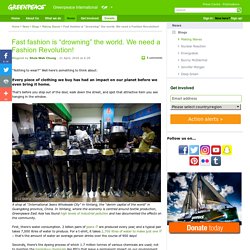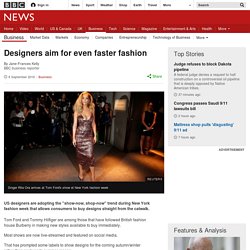

How ‘See Now, Buy Now’ Is Rewiring Creativity. NEW YORK, United States — Fourteen campaign images.

Six videos. A string of celebrity portraits. All in one day. “It was a large list of deliverables,” says photographer Inez van Lamsweerde, who, along with partner Vinoodh Matadin, was tasked with turning around all of the above in less than 24 hours. The client? But by the time the duo set a small studio up within the show venue — tapping the same hair and makeup artists that would prep the models for the runway — “it was a wonderful, easy process,” van Lamsweerde says. The day began at 10am, and they were finished shooting by the 4.30pm show rehearsal.
There’s not room to over think and there’s not room to question anything. Operationalising "see now, buy now" has implications across the value chain, from design to sales and marketing, rewiring the way not only designers, but fashion’s broader creative class do their jobs, from photographers and stylists to casting directors and visual merchandisers.
“We have a lot of experience. Fast fashion is “drowning” the world. We need a Fashion Revolution! “Nothing to wear?”

Well here’s something to think about: Every piece of clothing we buy has had an impact on our planet before we even bring it home. That’s before you step out of the door, walk down the street, and spot that attractive item you see hanging in the window. A shop at “International Jeans Wholesale City” in Xintang, the “denim capital of the world" in Guangdong province, China. In Xintang, where the economy is centred around textile production, Greenpeace East Asia has found high levels of industrial pollution and has documented the effects on the community. First, there’s water consumption. 2 billion pairs of jeans are produced every year, and a typical pair takes 7,000 litres of water to produce.
Secondly, there’s the dyeing process of which 1.7 million tonnes of various chemicals are used; not to mention the hazardous chemicals like PFCs that leave a permanent impact on our environment. Who Are the Fast Fashion Leaders And Why Does It Matter? Recently Sourcing Journal quoted John Thornbeck, chairman of Chainge Capital, that Fast Fashion is the rapid translation of design trends into multi-channel volume.

Fast Fashion may be the most important disrupter in the retail industry today. He also said that disruptive innovations, or product or services, that transform an existing market by introducing simplicity, convenience, accessibility and affordability, have the most positive impact on a company. Zara, Inditex’s leading brand, has been a groundbreaker in bringing new fashions, new designs, and new ideas quickly to its stores. Zara’s relentless push of on-trend merchandise into the supply chain pipeline keeps its stores in stock on the latest fashions at saleable prices. 5 New Solutions For The Fashion Industry's Sustainability Problem.
It's the holy grail for the fashion industry: Can manufacturers seamlessly close the loop on fabric, so an old T-shirt or dress headed for the landfill can be turned into something new?

The world now buys more clothing than ever before in history; the average American throws out 68 garments in a single year. A new €1 million competition asked for new ideas to help the industry become more circular. "Fashionista or not, clothes are a necessity, and one of the biggest challenges facing today's fashion industry is how to create fashion for a growing world population while protecting our planet," says Erik Bang, project manager for the Global Change Award, sponsored by H&M Conscious Foundation, the nonprofit created by the Swedish fast fashion giant. Fast fashion meets luxury labels. Buyer behaviour for fast fashion. Designers aim for even faster fashion. Image copyright Reuters US designers are adopting the "show-now, shop-now" trend during New York fashion week that allows consumers to buy designs straight from the catwalk.

Tom Ford and Tommy Hilfiger are among those that have followed British fashion house Burberry in making new styles available to buy immediately. Most shows are now live-streamed and featured on social media. That has prompted some labels to show designs for the coming autumn/winter rather than next year's summer ranges. Not having to wait for glossy fashion magazines to feature the latest designs has helped to make consumers less content to accept delays of several months before they can buy them. Tom Ford is showing an autumn/winter 2016 collection for both men and women at New York fashion week rather than items for spring/summer next year. Image copyright Getty Images. Opinion: Consumers have transformed the catwalk into a real-time runway. Ralph Lauren embraces the American West _ and fast fashion. By Associated Press Published: 04:16 GMT, 15 September 2016 | Updated: 04:16 GMT, 15 September 2016 NEW YORK (AP) — Call it "fast fashion," ''runway-to-retail," or "see now-buy now.

" No matter the term, it's the unmistakable trend in fashion, and Ralph Lauren embraced it fully — presenting his New York Fashion Week collection on the street outside his store, then inviting guests inside to buy what they'd just seen. "Today I am proud to share with you, for the first time ever, my new women's collection right off the runway and into your lives," the venerable designer wrote in a statement. "You are changing the way you live and the way you want to shop, and we are changing with you and for you. " Lauren's runway show Wednesday evening had the added cachet of literally stopping traffic — the block of Madison Avenue fronting his store was closed off for the glamorous event, held in a temporary glass structure that resembled a greenhouse.
But it wasn't plants people came to see.